https://github.com/serengil/deepface
A Lightweight Face Recognition and Facial Attribute Analysis (Age, Gender, Emotion and Race) Library for Python
https://github.com/serengil/deepface
age-prediction arcface deep-learning deepface deepid emotion-recognition face-analysis face-recognition facenet facial-expression-recognition facial-recognition gender-prediction machine-learning openface python race-classification vgg-face
Last synced: 7 months ago
JSON representation
A Lightweight Face Recognition and Facial Attribute Analysis (Age, Gender, Emotion and Race) Library for Python
- Host: GitHub
- URL: https://github.com/serengil/deepface
- Owner: serengil
- License: mit
- Created: 2020-02-08T20:42:28.000Z (almost 6 years ago)
- Default Branch: master
- Last Pushed: 2025-05-02T11:05:43.000Z (7 months ago)
- Last Synced: 2025-05-12T16:18:51.181Z (7 months ago)
- Topics: age-prediction, arcface, deep-learning, deepface, deepid, emotion-recognition, face-analysis, face-recognition, facenet, facial-expression-recognition, facial-recognition, gender-prediction, machine-learning, openface, python, race-classification, vgg-face
- Language: Python
- Homepage: https://bit.ly/deepface-py
- Size: 53.1 MB
- Stars: 18,977
- Watchers: 176
- Forks: 2,594
- Open Issues: 7
-
Metadata Files:
- Readme: README.md
- Funding: .github/FUNDING.yml
- License: LICENSE
- Code of conduct: .github/CODE_OF_CONDUCT.md
- Citation: CITATION.md
Awesome Lists containing this project
- awesome-list - Deepface - A Lightweight Face Recognition and Facial Attribute Analysis (Age, Gender, Emotion and Race) Library for Python. (Computer Vision / Classification & Detection & Tracking)
- awesome-face-detection-and-recognition - serengil/deepface
- StarryDivineSky - serengil/deepface
- AiTreasureBox - serengil/deepface - 11-03_20934_0](https://img.shields.io/github/stars/serengil/deepface.svg)|A Lightweight Face Recognition and Facial Attribute Analysis (Age, Gender, Emotion and Race) Library for Python| (Repos)
- Awesome-GitHub-Repo - deepface - Deepface 是一个用于 python 的轻量级人脸识别和人脸属性分析(年龄、性别、情感和种族)框架。它是一个混合人脸识别框架,包含最先进的模型:VGG-Face、Google FaceNet、OpenFace、Facebook DeepFace、DeepID、ArcFace 和 Dlib。 (实战项目 / 人脸识别项目)
- awesome-machine-learning - deepface - A lightweight face recognition and facial attribute analysis (age, gender, emotion and race) framework for Python covering cutting-edge models such as VGG-Face, FaceNet, OpenFace, DeepFace, DeepID, Dlib and ArcFace. (Python / General-Purpose Machine Learning)
- awesome-machine-learning - deepface - A lightweight face recognition and facial attribute analysis (age, gender, emotion and race) framework for Python covering cutting-edge models such as VGG-Face, FaceNet, OpenFace, DeepFace, DeepID, Dlib and ArcFace. (Python / General-Purpose Machine Learning)
- awesome-docker - Serengil/deepface
- awesome-ai-image - DeepFace - A lightweight face recognition and facial attribute analysis framework. (Facial Recognition)
- awesome - serengil/deepface - A Lightweight Face Recognition and Facial Attribute Analysis (Age, Gender, Emotion and Race) Library for Python (Python)
- fucking-awesome-machine-learning - deepface - A lightweight face recognition and facial attribute analysis (age, gender, emotion and race) framework for Python covering cutting-edge models such as VGG-Face, FaceNet, OpenFace, DeepFace, DeepID, Dlib and ArcFace. (Python / General-Purpose Machine Learning)
- awesome-machine-learning - deepface - A lightweight face recognition and facial attribute analysis (age, gender, emotion and race) framework for Python covering cutting-edge models such as VGG-Face, FaceNet, OpenFace, DeepFace, DeepID, Dlib and ArcFace. (Python / General-Purpose Machine Learning)
- awesome-resources - deepface - A lightweight face recognition and facial attribute analysis (age, gender, emotion and race) framework for Python covering cutting-edge models such as VGG-Face, FaceNet, OpenFace, DeepFace, DeepID, Dlib and ArcFace. (Uncategorized / Uncategorized)
- awesome-machine-learning - deepface - A lightweight face recognition and facial attribute analysis (age, gender, emotion and race) framework for Python covering cutting-edge models such as VGG-Face, FaceNet, OpenFace, DeepFace, DeepID, Dlib and ArcFace. (Python / General-Purpose Machine Learning)
- awesome - serengil/deepface - A Lightweight Face Recognition and Facial Attribute Analysis (Age, Gender, Emotion and Race) Library for Python (Python)
README
# deepface
[](https://pepy.tech/project/deepface)
[](https://github.com/serengil/deepface/stargazers)
[](https://hub.docker.com/r/serengil/deepface)
[](https://github.com/serengil/deepface/blob/master/LICENSE)
[](https://github.com/serengil/deepface/actions/workflows/tests.yml)
[](https://doi.org/10.17671/gazibtd.1399077)
[](https://sefiks.com)
[](https://www.youtube.com/@sefiks?sub_confirmation=1)
[](https://twitter.com/intent/user?screen_name=serengil)
[](https://www.patreon.com/serengil?repo=deepface)
[](https://github.com/sponsors/serengil)
[](https://buymeacoffee.com/serengil)
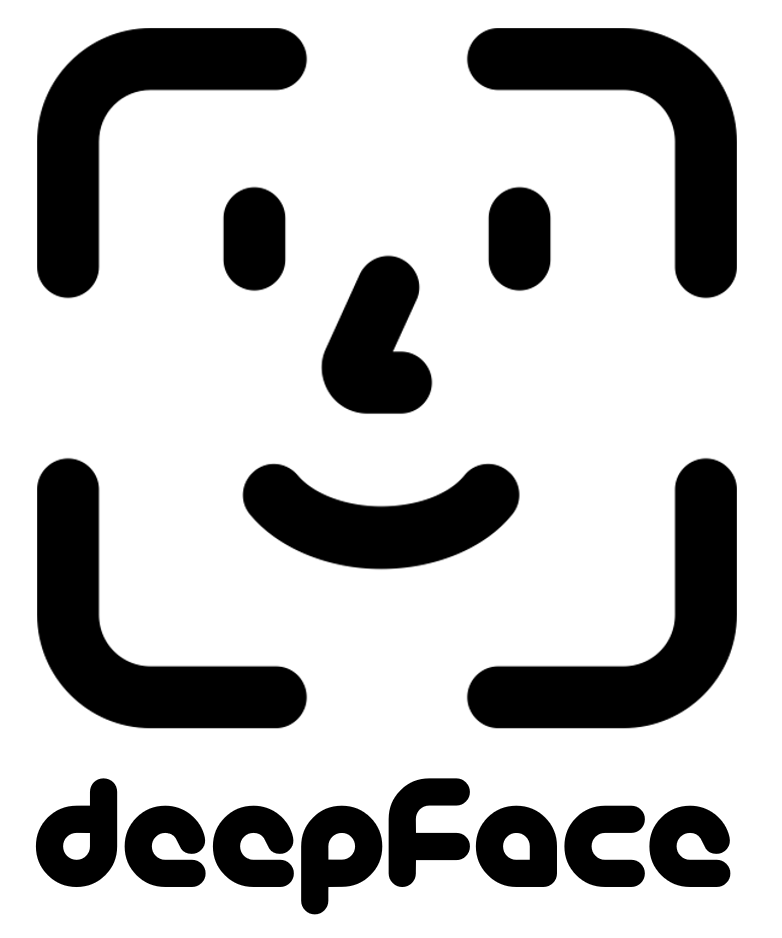
DeepFace is a lightweight [face recognition](https://sefiks.com/2018/08/06/deep-face-recognition-with-keras/) and facial attribute analysis ([age](https://sefiks.com/2019/02/13/apparent-age-and-gender-prediction-in-keras/), [gender](https://sefiks.com/2019/02/13/apparent-age-and-gender-prediction-in-keras/), [emotion](https://sefiks.com/2018/01/01/facial-expression-recognition-with-keras/) and [race](https://sefiks.com/2019/11/11/race-and-ethnicity-prediction-in-keras/)) framework for python. It is a hybrid face recognition framework wrapping **state-of-the-art** models: [`VGG-Face`](https://sefiks.com/2018/08/06/deep-face-recognition-with-keras/), [`FaceNet`](https://sefiks.com/2018/09/03/face-recognition-with-facenet-in-keras/), [`OpenFace`](https://sefiks.com/2019/07/21/face-recognition-with-openface-in-keras/), [`DeepFace`](https://sefiks.com/2020/02/17/face-recognition-with-facebook-deepface-in-keras/), [`DeepID`](https://sefiks.com/2020/06/16/face-recognition-with-deepid-in-keras/), [`ArcFace`](https://sefiks.com/2020/12/14/deep-face-recognition-with-arcface-in-keras-and-python/), [`Dlib`](https://sefiks.com/2020/07/11/face-recognition-with-dlib-in-python/), `SFace`, `GhostFaceNet`, `Buffalo_L`.
[`Experiments`](https://github.com/serengil/deepface/tree/master/benchmarks) show that **human beings have 97.53% accuracy** on facial recognition tasks whereas those models already reached and passed that accuracy level.
## Installation [](https://pypi.org/project/deepface/)
The easiest way to install deepface is to download it from [`PyPI`](https://pypi.org/project/deepface/). It's going to install the library itself and its prerequisites as well.
```shell
$ pip install deepface
```
Alternatively, you can also install deepface from its source code. Source code may have new features not published in pip release yet.
```shell
$ git clone https://github.com/serengil/deepface.git
$ cd deepface
$ pip install -e .
```
Once you installed the library, then you will be able to import it and use its functionalities.
```python
from deepface import DeepFace
```
**A Modern Facial Recognition Pipeline** - [`Demo`](https://youtu.be/WnUVYQP4h44)
A modern [**face recognition pipeline**](https://sefiks.com/2020/05/01/a-gentle-introduction-to-face-recognition-in-deep-learning/) consists of 5 common stages: [detect](https://sefiks.com/2020/08/25/deep-face-detection-with-opencv-in-python/), [align](https://sefiks.com/2020/02/23/face-alignment-for-face-recognition-in-python-within-opencv/), [normalize](https://sefiks.com/2020/11/20/facial-landmarks-for-face-recognition-with-dlib/), [represent](https://sefiks.com/2018/08/06/deep-face-recognition-with-keras/) and [verify](https://sefiks.com/2020/05/22/fine-tuning-the-threshold-in-face-recognition/). While DeepFace handles all these common stages in the background, you don’t need to acquire in-depth knowledge about all the processes behind it. You can just call its verification, find or analysis function with a single line of code.
**Face Verification** - [`Demo`](https://youtu.be/KRCvkNCOphE)
This function verifies face pairs as same person or different persons. It expects exact image paths as inputs. Passing numpy or base64 encoded images is also welcome. Then, it is going to return a dictionary and you should check just its verified key.
```python
result = DeepFace.verify(img1_path = "img1.jpg", img2_path = "img2.jpg")
```

**Face recognition** - [`Demo`](https://youtu.be/Hrjp-EStM_s)
[Face recognition](https://sefiks.com/2020/05/25/large-scale-face-recognition-for-deep-learning/) requires applying face verification many times. Herein, deepface has an out-of-the-box find function to handle this action. It's going to look for the identity of input image in the database path and it will return list of pandas data frame as output. Meanwhile, facial embeddings of the facial database are stored in a pickle file to be searched faster in next time. Result is going to be the size of faces appearing in the source image. Besides, target images in the database can have many faces as well.
```python
dfs = DeepFace.find(img_path = "img1.jpg", db_path = "C:/my_db")
```
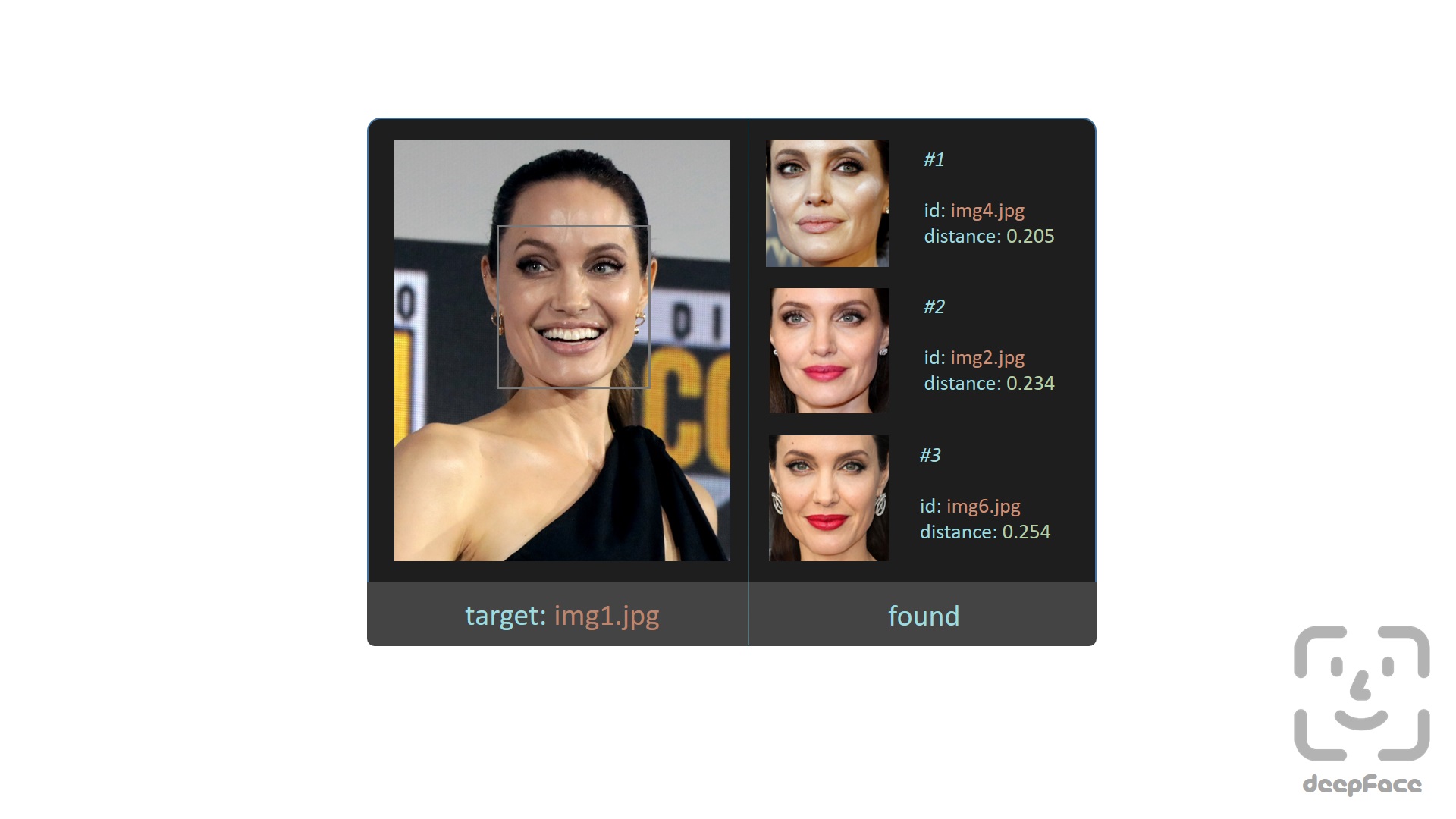
**Facial Attribute Analysis** - [`Demo`](https://youtu.be/GT2UeN85BdA)
DeepFace also comes with a strong facial attribute analysis module including [`age`](https://sefiks.com/2019/02/13/apparent-age-and-gender-prediction-in-keras/), [`gender`](https://sefiks.com/2019/02/13/apparent-age-and-gender-prediction-in-keras/), [`facial expression`](https://sefiks.com/2018/01/01/facial-expression-recognition-with-keras/) (including angry, fear, neutral, sad, disgust, happy and surprise) and [`race`](https://sefiks.com/2019/11/11/race-and-ethnicity-prediction-in-keras/) (including asian, white, middle eastern, indian, latino and black) predictions. Result is going to be the size of faces appearing in the source image.
```python
objs = DeepFace.analyze(
img_path = "img4.jpg", actions = ['age', 'gender', 'race', 'emotion']
)
```
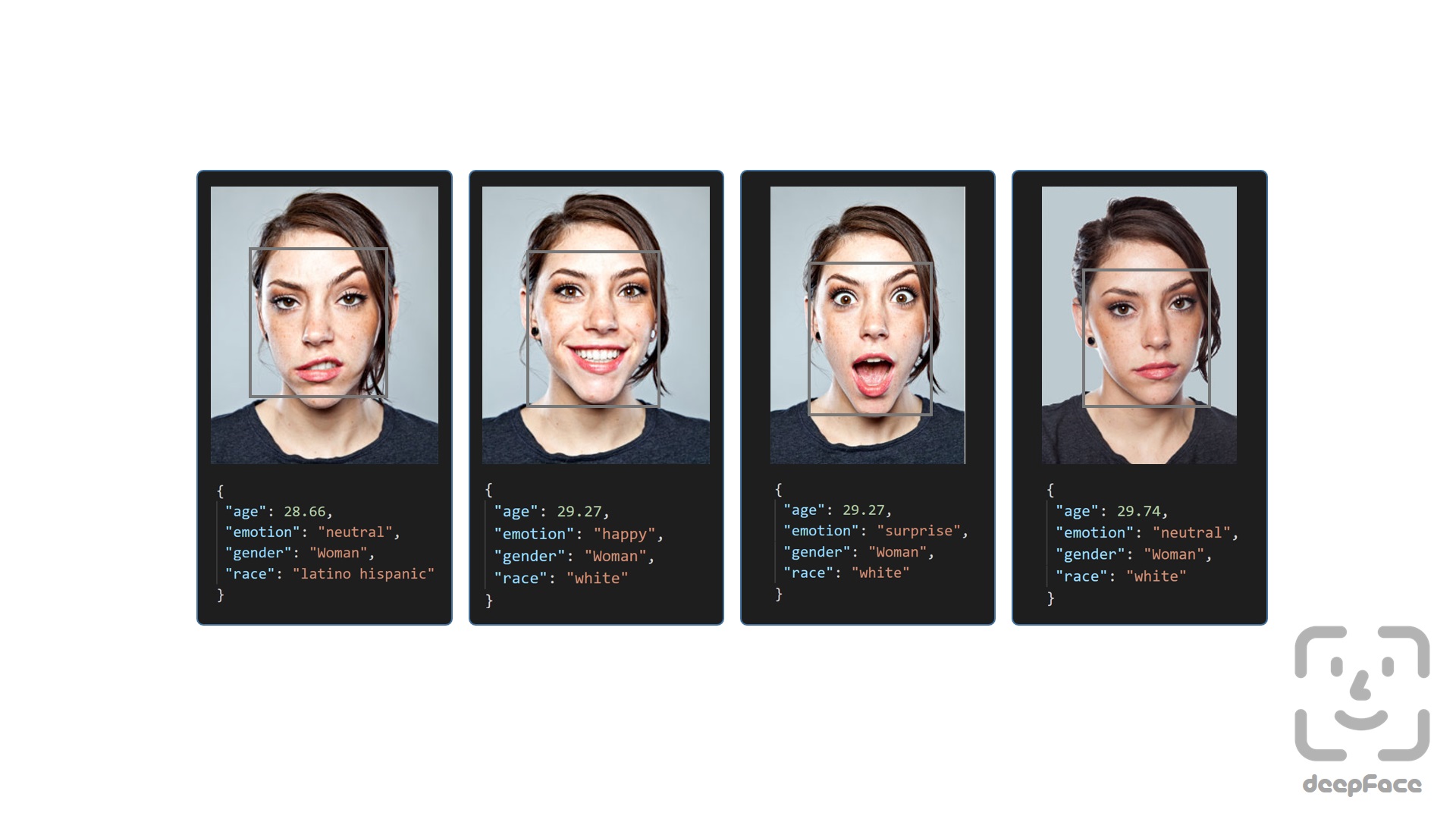
Age model got ± 4.65 MAE; gender model got 97.44% accuracy, 96.29% precision and 95.05% recall as mentioned in its [tutorial](https://sefiks.com/2019/02/13/apparent-age-and-gender-prediction-in-keras/).
**Real Time Analysis** - [`Demo`](https://youtu.be/-c9sSJcx6wI), [`React Demo part-i`](https://youtu.be/IXoah6rhxac), [`React Demo part-ii`](https://youtu.be/_waBA-cH2D4)
You can run deepface for real time videos as well. Stream function will access your webcam and apply both face recognition and facial attribute analysis. The function starts to analyze a frame if it can focus a face sequentially 5 frames. Then, it shows results 5 seconds.
```python
DeepFace.stream(db_path = "C:/database")
```

Even though face recognition is based on one-shot learning, you can use multiple face pictures of a person as well. You should rearrange your directory structure as illustrated below.
```bash
user
├── database
│ ├── Alice
│ │ ├── Alice1.jpg
│ │ ├── Alice2.jpg
│ ├── Bob
│ │ ├── Bob.jpg
```
If you intend to perform face verification or analysis tasks directly from your browser, [`deepface-react-ui`](https://github.com/serengil/deepface-react-ui) is a separate repository built using ReactJS depending on deepface api.
Here, you can also find some real time demos for various facial recognition models:
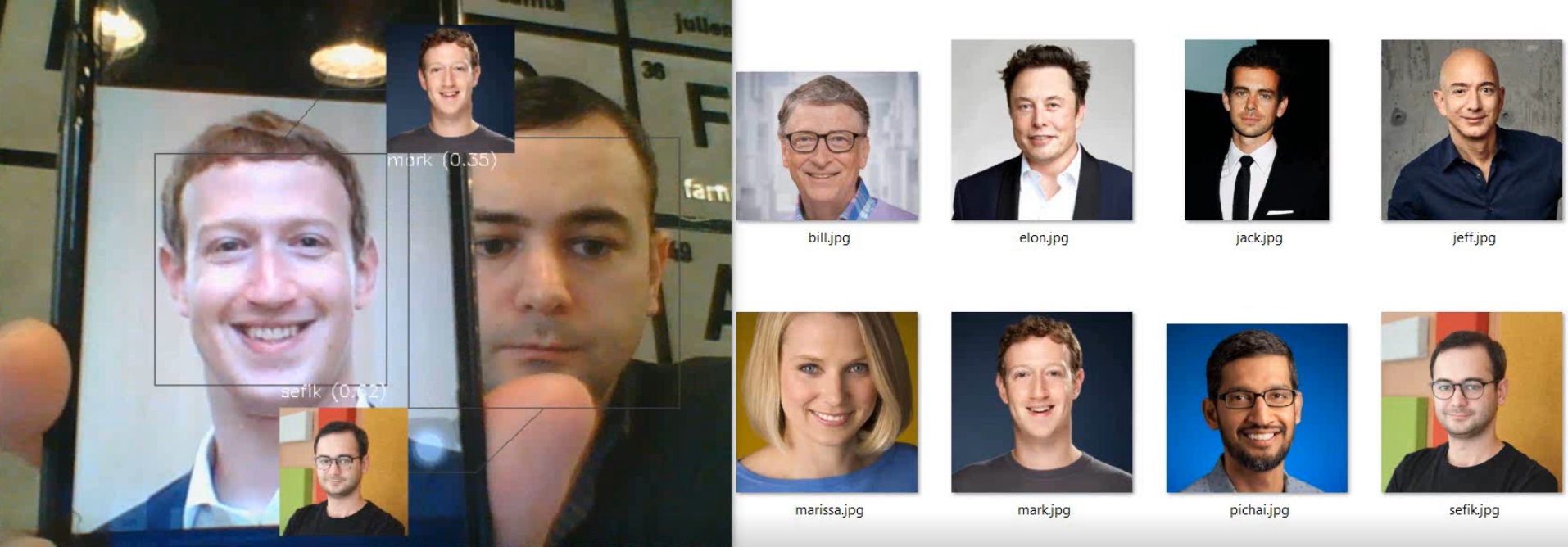
| Task | Model | Demo |
| --- | --- | --- |
| Facial Recognition | DeepFace | [`Video`](https://youtu.be/YjYIMs5ZOfc) |
| Facial Recognition | FaceNet | [`Video`](https://youtu.be/vB1I5vWgTQg) |
| Facial Recognition | VGG-Face | [`Video`](https://youtu.be/tSU_lNi0gQQ) |
| Facial Recognition | OpenFace | [`Video`](https://youtu.be/-4z2sL6wzP8) |
| Age & Gender | - | [`Video`](https://youtu.be/tFI7vZn3P7E) |
| Race & Ethnicity | - | [`Video`](https://youtu.be/-ztiy5eJha8) |
| Emotion | - | [`Video`](https://youtu.be/Y7DfLvLKScs) |
| Celebrity Look-Alike | - | [`Video`](https://youtu.be/RMgIKU1H8DY) |
**Embeddings** - [`Demo`](https://youtu.be/OYialFo7Qo4)
Face recognition models basically represent facial images as multi-dimensional vectors. Sometimes, you need those embedding vectors directly. DeepFace comes with a dedicated representation function. Represent function returns a list of embeddings. Result is going to be the size of faces appearing in the image path.
```python
embedding_objs = DeepFace.represent(img_path = "img.jpg")
```
Embeddings can be [plotted](https://sefiks.com/2020/05/01/a-gentle-introduction-to-face-recognition-in-deep-learning/) as below. Each slot is corresponding to a dimension value and dimension value is emphasized with colors. Similar to 2D barcodes, vertical dimension stores no information in the illustration.

**Face recognition models** - [`Demo`](https://youtu.be/eKOZawGR3y0)
DeepFace is a **hybrid** face recognition package. It currently wraps many **state-of-the-art** face recognition models: [`VGG-Face`](https://sefiks.com/2018/08/06/deep-face-recognition-with-keras/) , [`FaceNet`](https://sefiks.com/2018/09/03/face-recognition-with-facenet-in-keras/), [`OpenFace`](https://sefiks.com/2019/07/21/face-recognition-with-openface-in-keras/), [`DeepFace`](https://sefiks.com/2020/02/17/face-recognition-with-facebook-deepface-in-keras/), [`DeepID`](https://sefiks.com/2020/06/16/face-recognition-with-deepid-in-keras/), [`ArcFace`](https://sefiks.com/2020/12/14/deep-face-recognition-with-arcface-in-keras-and-python/), [`Dlib`](https://sefiks.com/2020/07/11/face-recognition-with-dlib-in-python/), `SFace`, `GhostFaceNet` and `Buffalo_L`. The default configuration uses VGG-Face model.
```python
models = [
"VGG-Face", "Facenet", "Facenet512", "OpenFace", "DeepFace",
"DeepID", "ArcFace", "Dlib", "SFace", "GhostFaceNet",
"Buffalo_L",
]
result = DeepFace.verify(
img1_path = "img1.jpg", img2_path = "img2.jpg", model_name = models[0]
)
dfs = DeepFace.find(
img_path = "img1.jpg", db_path = "C:/my_db", model_name = models[1]
)
embeddings = DeepFace.represent(
img_path = "img.jpg", model_name = models[2]
)
```

FaceNet, VGG-Face, ArcFace and Dlib are overperforming ones based on experiments - see [`BENCHMARKS`](https://github.com/serengil/deepface/tree/master/benchmarks) for more details. You can find the measured scores of various models in DeepFace and the reported scores from their original studies in the following table.
| Model | Measured Score | Declared Score |
| -------------- | -------------- | ------------------ |
| Facenet512 | 98.4% | 99.6% |
| Human-beings | 97.5% | 97.5% |
| Facenet | 97.4% | 99.2% |
| Dlib | 96.8% | 99.3 % |
| VGG-Face | 96.7% | 98.9% |
| ArcFace | 96.7% | 99.5% |
| GhostFaceNet | 93.3% | 99.7% |
| SFace | 93.0% | 99.5% |
| OpenFace | 78.7% | 92.9% |
| DeepFace | 69.0% | 97.3% |
| DeepID | 66.5% | 97.4% |
Conducting experiments with those models within DeepFace may reveal disparities compared to the original studies, owing to the adoption of distinct detection or normalization techniques. Furthermore, some models have been released solely with their backbones, lacking pre-trained weights. Thus, we are utilizing their re-implementations instead of the original pre-trained weights.
**Face Detection and Alignment** - [`Demo`](https://youtu.be/GZ2p2hj2H5k)
Face detection and alignment are important early stages of a modern face recognition pipeline. [Experiments](https://github.com/serengil/deepface/tree/master/benchmarks) show that detection increases the face recognition accuracy up to 42%, while alignment increases it up to 6%. [`OpenCV`](https://sefiks.com/2020/02/23/face-alignment-for-face-recognition-in-python-within-opencv/), [`Ssd`](https://sefiks.com/2020/08/25/deep-face-detection-with-opencv-in-python/), [`Dlib`](https://sefiks.com/2020/07/11/face-recognition-with-dlib-in-python/), [`MtCnn`](https://sefiks.com/2020/09/09/deep-face-detection-with-mtcnn-in-python/), `Faster MtCnn`, [`RetinaFace`](https://sefiks.com/2021/04/27/deep-face-detection-with-retinaface-in-python/), [`MediaPipe`](https://sefiks.com/2022/01/14/deep-face-detection-with-mediapipe/), `Yolo`, `YuNet` and `CenterFace` detectors are wrapped in deepface.

All deepface functions accept optional detector backend and align input arguments. You can switch among those detectors and alignment modes with these arguments. OpenCV is the default detector and alignment is on by default.
```python
backends = [
'opencv', 'ssd', 'dlib', 'mtcnn', 'fastmtcnn',
'retinaface', 'mediapipe', 'yolov8', 'yolov11s',
'yolov11n', 'yolov11m', 'yunet', 'centerface',
]
detector = backends[3]
align = True
obj = DeepFace.verify(
img1_path = "img1.jpg", img2_path = "img2.jpg", detector_backend = detector, align = align
)
dfs = DeepFace.find(
img_path = "img.jpg", db_path = "my_db", detector_backend = detector, align = align
)
embedding_objs = DeepFace.represent(
img_path = "img.jpg", detector_backend = detector, align = align
)
demographies = DeepFace.analyze(
img_path = "img4.jpg", detector_backend = detector, align = align
)
face_objs = DeepFace.extract_faces(
img_path = "img.jpg", detector_backend = detector, align = align
)
```
Face recognition models are actually CNN models and they expect standard sized inputs. So, resizing is required before representation. To avoid deformation, deepface adds black padding pixels according to the target size argument after detection and alignment.
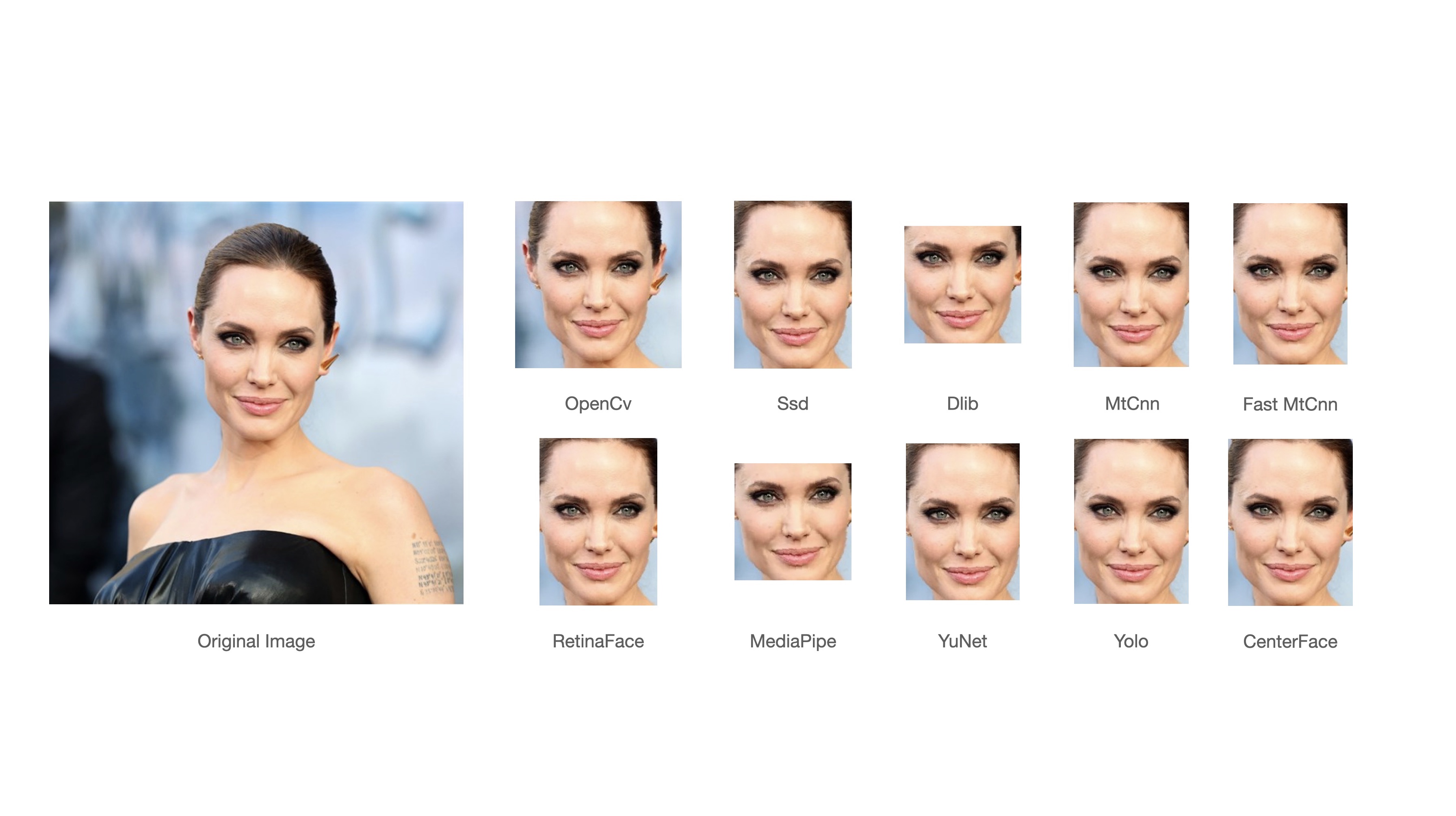
[RetinaFace](https://sefiks.com/2021/04/27/deep-face-detection-with-retinaface-in-python/) and [MtCnn](https://sefiks.com/2020/09/09/deep-face-detection-with-mtcnn-in-python/) seem to overperform in detection and alignment stages but they are much slower. If the speed of your pipeline is more important, then you should use opencv or ssd. On the other hand, if you consider the accuracy, then you should use retinaface or mtcnn.
The performance of RetinaFace is very satisfactory even in the crowd as seen in the following illustration. Besides, it comes with an incredible facial landmark detection performance. Highlighted red points show some facial landmarks such as eyes, nose and mouth. That's why, alignment score of RetinaFace is high as well.

The Yellow Angels - Fenerbahce Women's Volleyball Team
You can find out more about RetinaFace on this [repo](https://github.com/serengil/retinaface).
**Face Anti Spoofing** - [`Demo`](https://youtu.be/UiK1aIjOBlQ)
DeepFace also includes an anti-spoofing analysis module to understand given image is real or fake. To activate this feature, set the `anti_spoofing` argument to True in any DeepFace tasks.
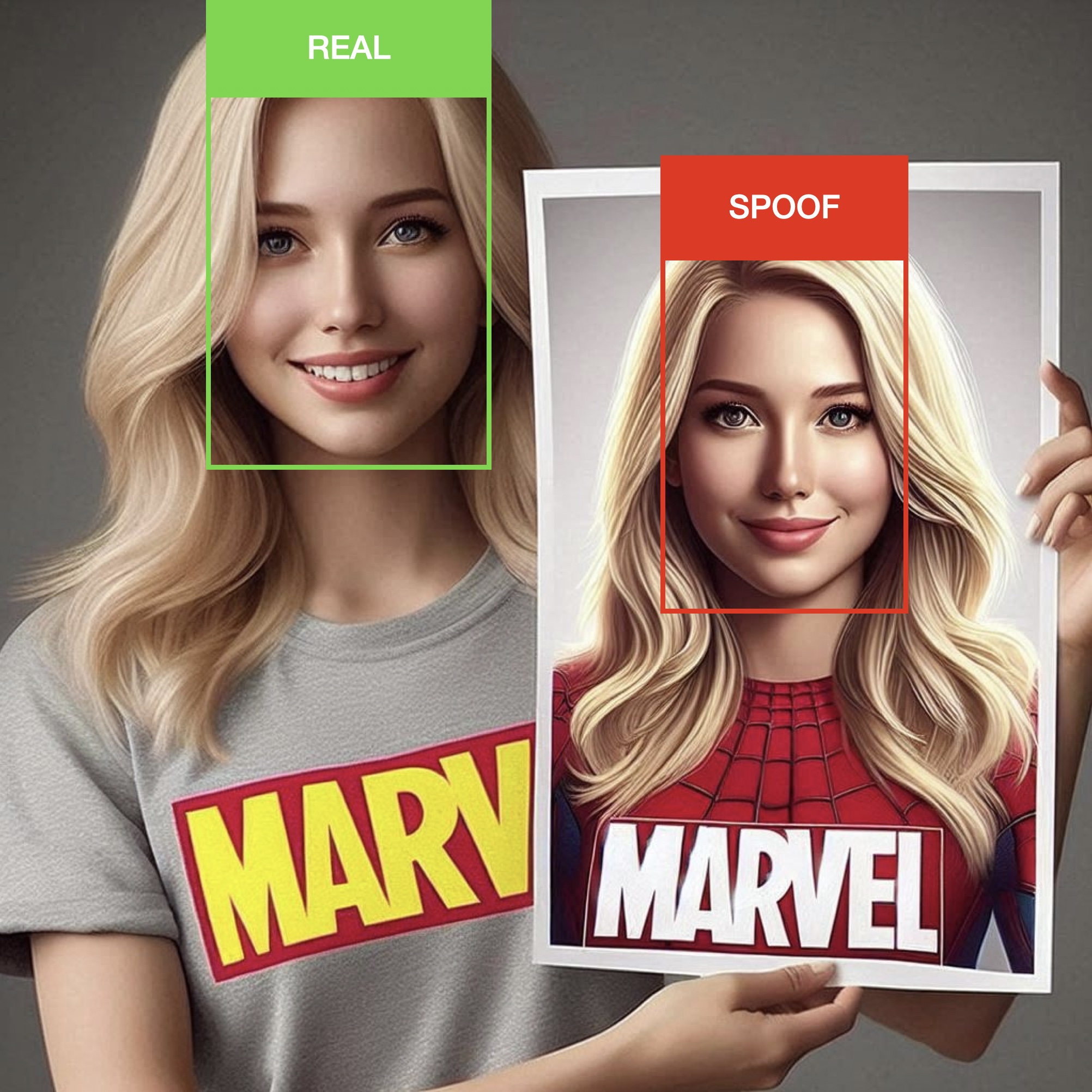
```python
# anti spoofing test in face detection
face_objs = DeepFace.extract_faces(img_path="dataset/img1.jpg", anti_spoofing = True)
assert all(face_obj["is_real"] is True for face_obj in face_objs)
# anti spoofing test in real time analysis
DeepFace.stream(db_path = "C:/database", anti_spoofing = True)
```
**Similarity** - [`Demo`](https://youtu.be/1EPoS69fHOc)
Face recognition models are regular [convolutional neural networks](https://sefiks.com/2018/03/23/convolutional-autoencoder-clustering-images-with-neural-networks/) and they are responsible to represent faces as vectors. We expect that a face pair of same person should be [more similar](https://sefiks.com/2020/05/22/fine-tuning-the-threshold-in-face-recognition/) than a face pair of different persons.
Similarity could be calculated by different metrics such as [Cosine Similarity](https://sefiks.com/2018/08/13/cosine-similarity-in-machine-learning/), Angular Distance, Euclidean Distance or L2 normalized Euclidean. The default configuration uses cosine similarity. According to [experiments](https://github.com/serengil/deepface/tree/master/benchmarks), no distance metric is overperforming than other.
```python
metrics = ["cosine", "euclidean", "euclidean_l2", "angular"]
result = DeepFace.verify(
img1_path = "img1.jpg", img2_path = "img2.jpg", distance_metric = metrics[1]
)
dfs = DeepFace.find(
img_path = "img1.jpg", db_path = "C:/my_db", distance_metric = metrics[2]
)
```
**API** - [`Demo`](https://youtu.be/HeKCQ6U9XmI), [`Docker Demo`](https://youtu.be/9Tk9lRQareA)
DeepFace serves an API as well - see [`api folder`](https://github.com/serengil/deepface/tree/master/deepface/api/src) for more details. You can clone deepface source code and run the api with the following command. It will use gunicorn server to get a rest service up. In this way, you can call deepface from an external system such as mobile app or web.
```shell
cd scripts
# run the service directly
./service.sh
# run the service via docker
./dockerize.sh
```
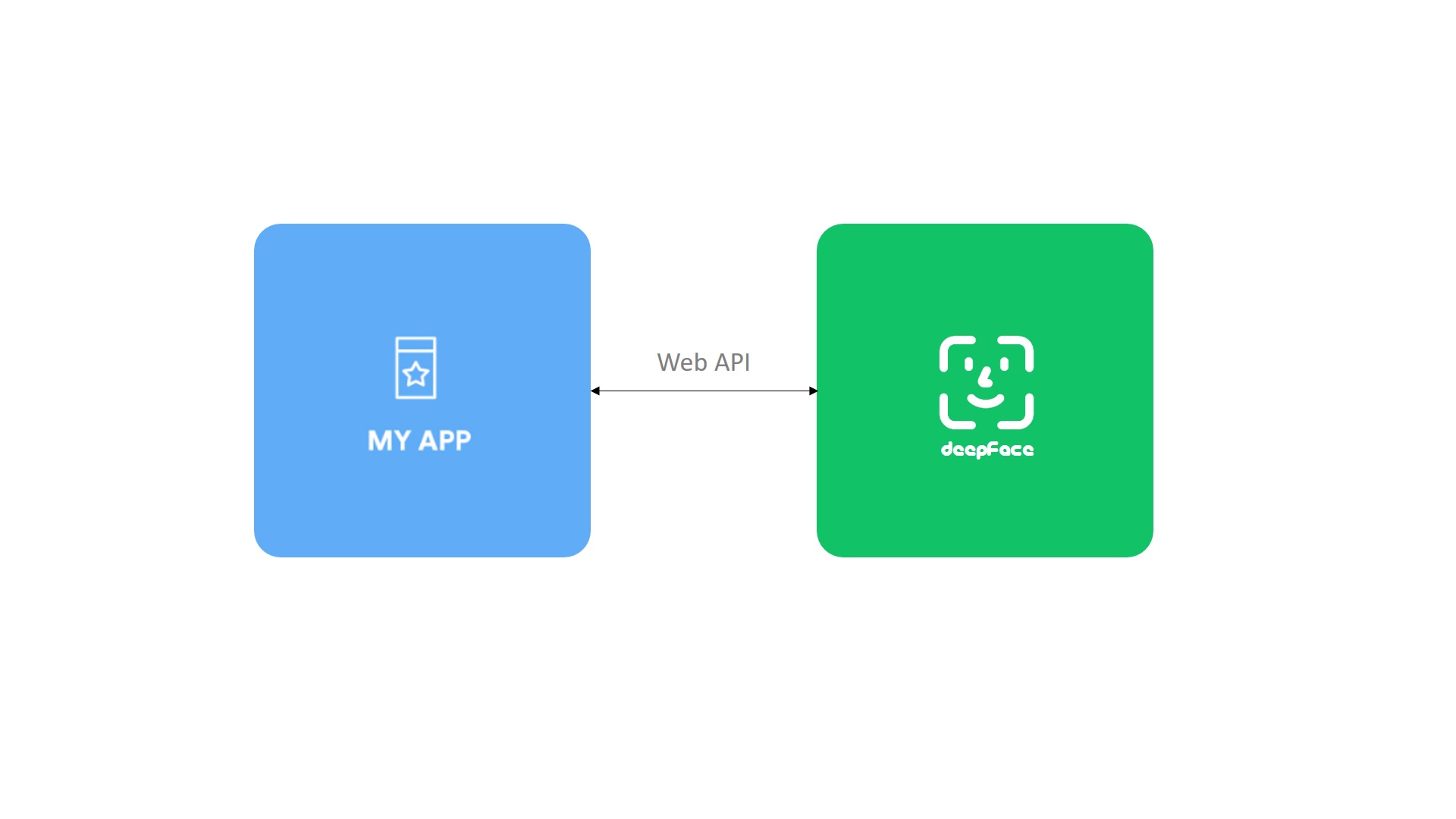
Face recognition, facial attribute analysis and vector representation functions are covered in the API. You are expected to call these functions as http post methods. Default service endpoints will be `http://localhost:5005/verify` for face recognition, `http://localhost:5005/analyze` for facial attribute analysis, and `http://localhost:5005/represent` for vector representation. The API accepts images as file uploads (via form data), or as exact image paths, URLs, or base64-encoded strings (via either JSON or form data), providing versatile options for different client requirements. [Here](https://github.com/serengil/deepface/tree/master/deepface/api/postman), you can find a postman project to find out how these methods should be called.
**Large Scale Facial Recognition** - [`Playlist`](https://www.youtube.com/playlist?list=PLsS_1RYmYQQGSJu_Z3OVhXhGmZ86_zuIm)
If your task requires facial recognition on large datasets, you should combine DeepFace with a vector index or vector database. This setup will perform [approximate nearest neighbor](https://youtu.be/c10w0Ptn_CU) searches instead of exact ones, allowing you to identify a face in a database containing billions of entries within milliseconds. Common vector index solutions include [Annoy](https://youtu.be/Jpxm914o2xk), [Faiss](https://youtu.be/6AmEvDTKT-k), [Voyager](https://youtu.be/2ZYTV9HlFdU), [NMSLIB](https://youtu.be/EVBhO8rbKbg), [ElasticSearch](https://youtu.be/i4GvuOmzKzo). For vector databases, popular options are [Postgres with its pgvector extension](https://youtu.be/Xfv4hCWvkp0) and [RediSearch](https://youtu.be/yrXlS0d6t4w).
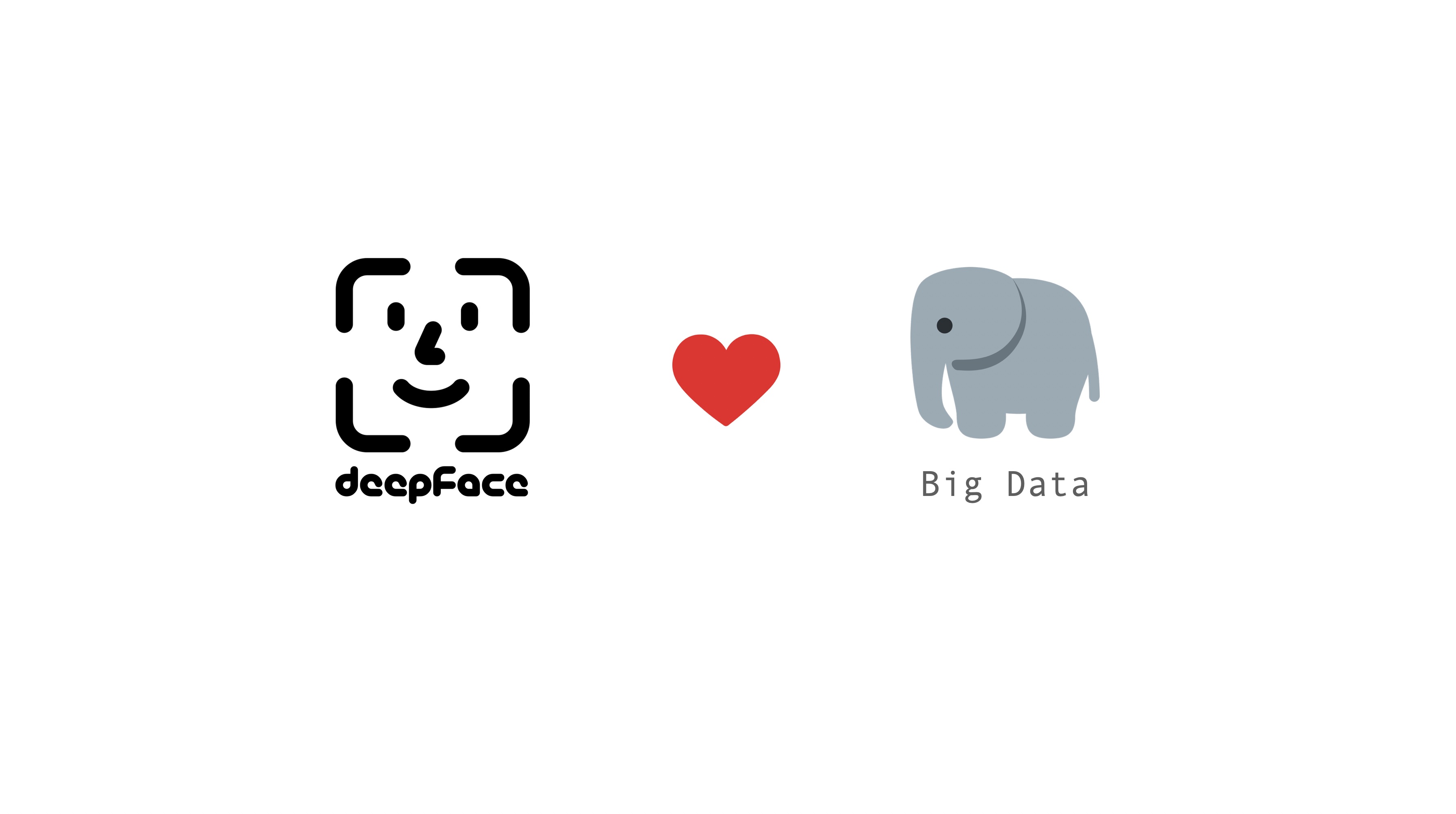
Conversely, if your task involves facial recognition on small to moderate-sized databases, you can adopt use relational databases such as [Postgres](https://youtu.be/f41sLxn1c0k) or [SQLite](https://youtu.be/_1ShBeWToPg), or NoSQL databases like [Mongo](https://youtu.be/dmprgum9Xu8), [Redis](https://youtu.be/X7DSpUMVTsw) or [Cassandra](https://youtu.be/J_yXpc3Y8Ec) to perform exact nearest neighbor search.
**Encrypt Embeddings** - [`Demo with PHE`](https://youtu.be/8VCu39jFZ7k), [`Tutorial for PHE`](https://sefiks.com/2025/03/04/vector-similarity-search-with-partially-homomorphic-encryption-in-python/), [`Demo with FHE`](https://youtu.be/njjw0PEhH00), [`Tutorial for FHE`](https://sefiks.com/2021/12/01/homomorphic-facial-recognition-with-tenseal/)
Even though vector embeddings are not reversible to original images, they still contain sensitive information similar to fingerprints, making their security critical. Encrypting embeddings is essential for higher security applications to prevent adversarial attacks that could manipulate or extract sensitive information. Traditional encryption methods like AES are very safe but limited in securely utilizing cloud computational power for distance calculations. Herein, [homomorphic encryption](https://youtu.be/3ejI0zNPMEQ), allowing calculations on encrypted data without private key, offers a robust alternative for cloud.
```python
from lightphe import LightPHE
# build an additively homomorphic cryptosystem (e.g. Paillier) on-prem
cs = LightPHE(algorithm_name = "Paillier", precision = 19)
# define plain vectors for source and target
alpha = DeepFace.represent("img1.jpg")[0]["embedding"]
beta = DeepFace.represent("target.jpg")[0]["embedding"]
# encrypt source embedding on-prem - private key not required
encrypted_alpha = cs.encrypt(alpha)
# dot product of encrypted & plain embedding in cloud - private key not required
encrypted_cosine_similarity = encrypted_alpha @ beta
# decrypt similarity on-prem - private key required
calculated_similarity = cs.decrypt(encrypted_cosine_similarity)[0]
# verification
print("same person" if calculated_similarity >= 1 - threshold else "different persons")
```

In this scheme, we leverage the computational power of the cloud to compute encrypted cosine similarity. However, the cloud has no knowledge of the actual calculations it performs. That's the **magic** of homomorphic encryption! Only the secret key holder on the on-premises side can decrypt the encrypted cosine similarity and determine whether the pair represents the same person or different individuals. Check out [`LightPHE`](https://github.com/serengil/LightPHE) library to find out more about partially homomorphic encryption.
As an alternative to partially homomorphic encryption, you can also choose to use fully homomorphic encryption. In this case, you'll compute the dot product between encrypted embeddings, rather than between encrypted and plain embeddings. To learn more about fully homomorphic encryption, check out the [`CipherFace`](https://github.com/serengil/cipherface) library. However, keep in mind that FHE is significantly more computationally expensive than PHE.
### Extended Applications
DeepFace can also be used for fun and insightful applications such as
**Find Your Celebrity Look-Alike** - [`Demo`](https://youtu.be/jaxkEn-Kieo), [`Real-Time Demo`](https://youtu.be/RMgIKU1H8DY), [`Tutorial`](https://sefiks.com/2019/05/05/celebrity-look-alike-face-recognition-with-deep-learning-in-keras/)
DeepFace can analyze your facial features and match them with celebrities, letting you discover which famous personality you resemble the most.

**Find Which Parent a Child Look More** - [`Demo`](https://youtu.be/nza4tmi9vhE), [`Tutorial`](https://sefiks.com/2022/12/22/decide-whom-your-child-looks-like-with-facial-recognition-mommy-or-daddy/)
DeepFace can also be used to compare a child's face to their parents' or relatives' faces to determine which one the child resembles more.

## Contribution
Pull requests are more than welcome! If you are planning to contribute a large patch, please create an issue first to get any upfront questions or design decisions out of the way first.
Before creating a PR, you should run the unit tests and linting locally by running `make test && make lint` command. Once a PR sent, GitHub test workflow will be run automatically and unit test and linting jobs will be available in [GitHub actions](https://github.com/serengil/deepface/actions) before approval.
## Support
There are many ways to support a project - starring⭐️ the GitHub repo is just one 🙏
If you do like this work, then you can support it financially on [Patreon](https://www.patreon.com/serengil?repo=deepface), [GitHub Sponsors](https://github.com/sponsors/serengil) or [Buy Me a Coffee](https://buymeacoffee.com/serengil). Also, your company's logo will be shown on README on GitHub if you become a sponsor in gold, silver or bronze tiers.
## Citation
Please cite deepface in your publications if it helps your research.
S. Serengil and A. Ozpinar, "A Benchmark of Facial Recognition Pipelines and Co-Usability Performances of Modules", Journal of Information Technologies, vol. 17, no. 2, pp. 95-107, 2024.
```BibTeX
@article{serengil2024lightface,
title = {A Benchmark of Facial Recognition Pipelines and Co-Usability Performances of Modules},
author = {Serengil, Sefik and Ozpinar, Alper},
journal = {Journal of Information Technologies},
volume = {17},
number = {2},
pages = {95-107},
year = {2024},
doi = {10.17671/gazibtd.1399077},
url = {https://dergipark.org.tr/en/pub/gazibtd/issue/84331/1399077},
publisher = {Gazi University}
}
```
S. I. Serengil and A. Ozpinar, "LightFace: A Hybrid Deep Face Recognition Framework", 2020 Innovations in Intelligent Systems and Applications Conference (ASYU), 2020, pp. 23-27.
```BibTeX
@inproceedings{serengil2020lightface,
title = {LightFace: A Hybrid Deep Face Recognition Framework},
author = {Serengil, Sefik Ilkin and Ozpinar, Alper},
booktitle = {2020 Innovations in Intelligent Systems and Applications Conference (ASYU)},
pages = {23-27},
year = {2020},
doi = {10.1109/ASYU50717.2020.9259802},
url = {https://ieeexplore.ieee.org/document/9259802},
organization = {IEEE}
}
```
S. I. Serengil and A. Ozpinar, "HyperExtended LightFace: A Facial Attribute Analysis Framework", 2021 International Conference on Engineering and Emerging Technologies (ICEET), 2021, pp. 1-4.
```BibTeX
@inproceedings{serengil2021lightface,
title = {HyperExtended LightFace: A Facial Attribute Analysis Framework},
author = {Serengil, Sefik Ilkin and Ozpinar, Alper},
booktitle = {2021 International Conference on Engineering and Emerging Technologies (ICEET)},
pages = {1-4},
year = {2021},
doi = {10.1109/ICEET53442.2021.9659697},
url = {https://ieeexplore.ieee.org/document/9659697},
organization = {IEEE}
}
```
S. Serengil and A. Ozpinar, "Encrypted Vector Similarity Computations Using Partially Homomorphic Encryption: Applications and Performance Analysis", arXiv preprint arXiv:2503.05850, 2025.
```BibTeX
@article{serengil2025vectorsimilarity,
title={Encrypted Vector Similarity Computations Using Partially Homomorphic Encryption: Applications and Performance Analysis},
author={Serengil, Sefik and Ozpinar, Alper},
journal={arXiv preprint arXiv:2503.05850},
note={doi: 10.48550/arXiv.2503.05850. [Online]. Available: \url{https://arxiv.org/abs/2503.05850}},
year={2025}
}
```
Also, if you use deepface in your GitHub projects, please add `deepface` in the `requirements.txt`.
## Licence
DeepFace is licensed under the MIT License - see [`LICENSE`](https://github.com/serengil/deepface/blob/master/LICENSE) for more details.
DeepFace wraps some external face recognition models: [VGG-Face](http://www.robots.ox.ac.uk/~vgg/software/vgg_face/), [Facenet](https://github.com/davidsandberg/facenet/blob/master/LICENSE.md) (both 128d and 512d), [OpenFace](https://github.com/iwantooxxoox/Keras-OpenFace/blob/master/LICENSE), [DeepFace](https://github.com/swghosh/DeepFace), [DeepID](https://github.com/Ruoyiran/DeepID/blob/master/LICENSE.md), [ArcFace](https://github.com/leondgarse/Keras_insightface/blob/master/LICENSE), [Dlib](https://github.com/davisking/dlib/blob/master/dlib/LICENSE.txt), [SFace](https://github.com/opencv/opencv_zoo/blob/master/models/face_recognition_sface/LICENSE), [GhostFaceNet](https://github.com/HamadYA/GhostFaceNets/blob/main/LICENSE) and
[Buffalo_L](https://github.com/deepinsight/insightface/blob/master/README.md). Besides, age, gender and race / ethnicity models were trained on the backbone of VGG-Face with transfer learning. Similarly, DeepFace wraps many face detectors: [OpenCv](https://github.com/opencv/opencv/blob/4.x/LICENSE), [Ssd](https://github.com/opencv/opencv/blob/master/LICENSE), [Dlib](https://github.com/davisking/dlib/blob/master/LICENSE.txt), [MtCnn](https://github.com/ipazc/mtcnn/blob/master/LICENSE), [Fast MtCnn](https://github.com/timesler/facenet-pytorch/blob/master/LICENSE.md), [RetinaFace](https://github.com/serengil/retinaface/blob/master/LICENSE), [MediaPipe](https://github.com/google/mediapipe/blob/master/LICENSE), [YuNet](https://github.com/ShiqiYu/libfacedetection/blob/master/LICENSE), [Yolo](https://github.com/derronqi/yolov8-face/blob/main/LICENSE) and [CenterFace](https://github.com/Star-Clouds/CenterFace/blob/master/LICENSE). Finally, DeepFace is optionally using [face anti spoofing](https://github.com/minivision-ai/Silent-Face-Anti-Spoofing/blob/master/LICENSE) to determine the given images are real or fake. License types will be inherited when you intend to utilize those models. Please check the license types of those models for production purposes.
DeepFace [logo](https://thenounproject.com/term/face-recognition/2965879/) is created by [Adrien Coquet](https://thenounproject.com/coquet_adrien/) and it is licensed under [Creative Commons: By Attribution 3.0 License](https://creativecommons.org/licenses/by/3.0/).